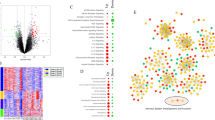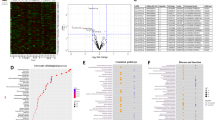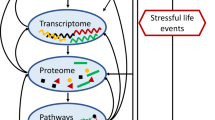Abstract
Previous imaging and postmortem studies have reported a lower brain volume and a smaller size and density of neurons in the dorsolateral prefrontal cortex (dlPFC) of subjects with major depressive disorder (MDD)1,2. These findings suggest that synapse number and function are decreased in the dlPFC of patients with MDD. However, there has been no direct evidence reported for synapse loss in MDD, and the gene expression alterations underlying these effects have not been identified. Here we use microarray gene profiling and electron microscopic stereology to reveal lower expression of synaptic-function–related genes (CALM2, SYN1, RAB3A, RAB4B and TUBB4) in the dlPFC of subjects with MDD and a corresponding lower number of synapses. We also identify a transcriptional repressor, GATA1, expression of which is higher in MDD and that, when expressed in PFC neurons, is sufficient to decrease the expression of synapse-related genes, cause loss of dendritic spines and dendrites, and produce depressive behavior in rat models of depression.
This is a preview of subscription content, access via your institution
Access options
Subscribe to this journal
Receive 12 print issues and online access
$209.00 per year
only $17.42 per issue
Buy this article
- Purchase on Springer Link
- Instant access to full article PDF
Prices may be subject to local taxes which are calculated during checkout




Similar content being viewed by others
References
Rajkowska, G. et al. Morphometric evidence for neuronal and glial prefrontal cell pathology in major depression. Biol. Psychiatry 45, 1085–1098 (1999).
Drevets, W.C. Functional anatomical abnormalities in limbic and prefrontal cortical structures in major depression. Prog. Brain Res. 126, 413–431 (2000).
Lecrubier, Y. The burden of depression and anxiety in general medicine. J. Clin. Psychiatry 62 (suppl. 8), 4–9 (2001).
Boyle, L.L., Porsteinsson, A.P., Cui, X., King, D.A. & Lyness, J.M. Depression predicts cognitive disorders in older primary care patients. J. Clin. Psychiatry 71, 74–79 (2010).
Barabassy, A., Beinhoff, U. & Riepe, M.W. Cognitive estimation in aged patients with major depressive disorder. Psychiatry Res. 176, 26–29 (2010).
Levens, S.M. & Gotlib, I.H. Impaired selection of relevant positive information in depression. Depress. Anxiety 26, 403–410 (2009).
Radley, J.J. et al. Repeated stress induces dendritic spine loss in the rat medial prefrontal cortex. Cereb. Cortex 16, 313–320 (2006).
Liu, R.J. & Aghajanian, G.K. Stress blunts serotonin- and hypocretin-evoked EPSCs in prefrontal cortex: role of corticosterone-mediated apical dendritic atrophy. Proc. Natl. Acad. Sci. USA 105, 359–364 (2008).
Bianchi, M., Hagan, J.J. & Heidbreder, C.A. Neuronal plasticity, stress and depression: involvement of the cytoskeletal microtubular system? Curr. Drug Targets CNS Neurol. Disord. 4, 597–611 (2005).
Drevets, W.C. et al. Subgenual prefrontal cortex abnormalities in mood disorders. Nature 386, 824–827 (1997).
Kang, H.J. et al. Gene expression profiling in postmortem prefrontal cortex of major depressive disorder. J. Neurosci. 27, 13329–13340 (2007).
DeLorenzo, R.J. & Freedman, S.D. Calcium dependent neurotransmitter release and protein phosphorylation in synaptic vesicles. Biochem. Biophys. Res. Commun. 80, 183–192 (1978).
De Camilli, P. & Greengard, P. Synapsin I: a synaptic vesicle-associated neuronal phosphoprotein. Biochem. Pharmacol. 35, 4349–4357 (1986).
Elferink, L.A. & Scheller, R.H. Synaptic vesicle proteins and regulated exocytosis. Prog. Brain Res. 105, 79–85 (1995).
Wigge, P. & McMahon, H.T. The amphiphysin family of proteins and their role in endocytosis at the synapse. Trends Neurosci. 21, 339–344 (1998).
Belizaire, R. et al. Characterization of synaptogyrin 3 as a new synaptic vesicle protein. J. Comp. Neurol. 470, 266–281 (2004).
Zhong, L., Cherry, T., Bies, C.E., Florence, M.A. & Gerges, N.Z. Neurogranin enhances synaptic strength through its interaction with calmodulin. EMBO J. 28, 3027–3039 (2009).
Brown, T.C., Correia, S.S., Petrok, C.N. & Esteban, J.A. Functional compartmentalization of endosomal trafficking for the synaptic delivery of AMPA receptors during long-term potentiation. J. Neurosci. 27, 13311–13315 (2007).
Hoffman, P.N. Distinct roles of neurofilament and tubulin gene expression in axonal growth. Ciba Found. Symp. 138, 192–204 (1988).
Kim, S. & Webster, M.J. Correlation analysis between genome-wide expression profiles and cytoarchitectural abnormalities in the prefrontal cortex of psychiatric disorders. Mol. Psychiatry 15, 326–336 (2010).
Kim, S. & Webster, M.J. Integrative genome-wide association analysis of cytoarchitectural abnormalities in the prefrontal cortex of psychiatric disorders. Mol. Psychiatry 16, 452–461 (2011).
Tochigi, M. et al. Gene expression profiling of major depression and suicide in the prefrontal cortex of postmortem brains. Neurosci. Res. 60, 184–191 (2008).
Sequeira, A. et al. Global brain gene expression analysis links glutamatergic and GABAergic alterations to suicide and major depression. PLoS ONE 4, e6585 (2009).
Aston, C., Jiang, L. & Sokolov, B.P. Transcriptional profiling reveals evidence for signaling and oligodendroglial abnormalities in the temporal cortex from patients with major depressive disorder. Mol. Psychiatry 10, 309–322 (2005).
Tsang, A.P. et al. FOG, a multitype zinc finger protein, acts as a cofactor for transcription factor GATA-1 in erythroid and megakaryocytic differentiation. Cell 90, 109–119 (1997).
Johnson, K.D., Kim, S.I. & Bresnick, E.H. Differential sensitivities of transcription factor target genes underlie cell type-specific gene expression profiles. Proc. Natl. Acad. Sci. USA 103, 15939–15944 (2006).
Willner, P. Validity, reliability and utility of the chronic mild stress model of depression: a 10-year review and evaluation. Psychopharmacology (Berl.) 134, 319–329 (1997).
Baldelli, P., Fassio, A., Valtorta, F. & Benfenati, F. Lack of synapsin I reduces the readily releasable pool of synaptic vesicles at central inhibitory synapses. J. Neurosci. 27, 13520–13531 (2007).
Geppert, M., Goda, Y., Stevens, C.F. & Sudhof, T.C. The small GTP-binding protein Rab3A regulates a late step in synaptic vesicle fusion. Nature 387, 810–814 (1997).
Matthews, G. Calcium/calmodulin: a synaptic antidepressant? Neuron 32, 962–963 (2001).
Pang, Z.P., Cao, P., Xu, W. & Sudhof, T.C. Calmodulin controls synaptic strength via presynaptic activation of calmodulin kinase II. J. Neurosci. 30, 4132–4142 (2010).
Hoogenraad, C.C. et al. Neuron specific Rab4 effector GRASP-1 coordinates membrane specialization and maturation of recycling endosomes. PLoS Biol. 8, e1000283 (2010).
Gorwood, P. [Severe depression: genes and the environment]. Encephale 35 (suppl. 7), S306–S309 (2009).
Hammen, C. Stress and depression. Annu. Rev. Clin. Psychol. 1, 293–319 (2005).
Viger, R.S., Guittot, S.M., Anttonen, M., Wilson, D.B. & Heikinheimo, M. Role of the GATA family of transcription factors in endocrine development, function, and disease. Mol. Endocrinol. 22, 781–798 (2008).
Nardelli, J., Thiesson, D., Fujiwara, Y., Tsai, F.Y. & Orkin, S.H. Expression and genetic interaction of transcription factors GATA-2 and GATA-3 during development of the mouse central nervous system. Dev. Biol. 210, 305–321 (1999).
Kala, K. et al. Gata2 is a tissue-specific post-mitotic selector gene for midbrain GABAergic neurons. Development 136, 253–262 (2009).
El Wakil, A., Francius, C., Wolff, A., Pleau-Varet, J. & Nardelli, J. The GATA2 transcription factor negatively regulates the proliferation of neuronal progenitors. Development 133, 2155–2165 (2006).
Cole, S.W. et al. Computational identification of gene-social environment interaction at the human IL6 locus. Proc. Natl. Acad. Sci. USA 107, 5681–5686 (2010).
Li, N. et al. mTOR-dependent synapse formation underlies the rapid antidepressant effects of NMDA antagonists. Science 329, 959–964 (2010).
Hajszan, T. et al. Remodeling of hippocampal spine synapses in the rat learned helplessness model of depression. Biol. Psychiatry 65, 392–400 (2009).
Hajszan, T. et al. Effects of estradiol on learned helplessness and associated remodeling of hippocampal spine synapses in female rats. Biol. Psychiatry 67, 168–174 (2010).
Noh, J.S. & Gwag, B.J. Attenuation of oxidative neuronal necrosis by a dopamine D1 agonist in mouse cortical cell cultures. Exp. Neurol. 146, 604–608 (1997).
Sholl, D.A. Dendritic organization in the neurons of the visual and motor cortices of the cat. J. Anat. 87, 387–406 (1953).
Valentine, G., Dow, A., Banasr, M., Pittman, B. & Duman, R. Differential effects of chronic antidepressant treatment on shuttle box escape deficits induced by uncontrollable stress. Psychopharmacology (Berl.) 200, 585–596 (2008).
Banasr, M. et al. Chronic unpredictable stress decreases cell proliferation in the cerebral cortex of the adult rat. Biol. Psychiatry 62, 496–504 (2007).
Pliakas, A.M. et al. Altered responsiveness to cocaine and increased immobility in the forced swim test associated with elevated cAMP response element-binding protein expression in nucleus accumbens. J. Neurosci. 21, 7397–7403 (2001).
Acknowledgements
This work is supported by US Public Health Service grants MH45481 (R.S.D.), 2 P01 MH25642 (R.S.D.), MH67996 (C.A.S.) and P20 RR17701 (C.A.S.), the Connecticut Mental Health Center (R.S.D.) and a National Research Foundation of Korea grant (NRF, 2011-0028317; H.S.). We acknowledge the invaluable contributions made by the families consenting to donate brain tissue and be interviewed. We also thank the Cuyahoga County Coroner and staff, Cleveland, Ohio, for their willing assistance. We thank J. Overholser, G. Jurjus, H. Meltzer, L. Konick, L. Dieter, N. Herbst, G. Mahajan, H. Kooiman and J. Cobb for their contributions to the psychiatric assessment and human tissue dissection and preparation. We thank T.H. Kim (Yale University) for his advice and suggestions regarding the binding motif analysis and chromatin immunoprecipitation. The pXM-GATA1 plasmid was provided by A.B. Cantor (Harvard University), and the pAAV-eGFP-pA vector was provided by R.J. Dileone (Yale University). The GATA1-specific antibody was provided by E.H. Bresnick (University of Wisconsin).
Author information
Authors and Affiliations
Contributions
H.J.K. was involved in planning and conducting all aspects of the research, including the analysis of microarray data, the confirmation of results, the molecular and cellular experiments and the construction of the viral vectors; H.J.K. also prepared the first draft of the manuscript. B.V. designed viral vectors, conducted the behavioral studies and was involved in the analysis and interpretation of rodent behavioral studies. C.A.S. and G.R. were responsible for the generation of tables containing the relevant information from the human subjects and the corresponding methodology and for preparation of human tissue and microdissections. T.H. conducted electron microscopy analysis of synapse number in postmortem tissue. M.B., with the technical help of A.L., carried out the rat CUS studies and prepared tissues for in situ hybridization analysis, surgeries for viral infusion in rats and supervised behavioral studies. P.L. was involved in the viral vector preparations. H.S. was involved in viral vector experiments, including surgical infusions, behavioral studies and immunohistochemistry. M.S.M. and L.S.J. synthesized the GATA1-specific inhibitor, K-7174. R.S.D. was responsible for overseeing the study, including all aspects of study design, data analysis, interpretation of results and preparation of the manuscript and figures. All authors discussed the results presented in the manuscript.
Corresponding author
Ethics declarations
Competing interests
The authors declare no competing financial interests.
Supplementary information
Supplementary Text and Figures
Supplementary Figures 1–7 (PDF 515 kb)
Supplementary Table 1
Synaptic enriched genes were decreased in MDD (XLS 28 kb)
Supplementary Table 2
TRANSFAC MATRIX of the synapse related genes_Human (XLS 6368 kb)
Supplementary Table 3
TRNASFAC MATRIX of the synapse related genes_Rat (XLS 4874 kb)
Supplementary Table 4
List of PCR primers used in this study for validation (XLS 33 kb)
Rights and permissions
About this article
Cite this article
Kang, H., Voleti, B., Hajszan, T. et al. Decreased expression of synapse-related genes and loss of synapses in major depressive disorder. Nat Med 18, 1413–1417 (2012). https://doi.org/10.1038/nm.2886
Received:
Accepted:
Published:
Issue Date:
DOI: https://doi.org/10.1038/nm.2886
This article is cited by
-
Sigma-1 receptor activation mediates the sustained antidepressant effect of ketamine in mice via increasing BDNF levels
Acta Pharmacologica Sinica (2024)
-
Plasticity of synapses and reward circuit function in the genesis and treatment of depression
Neuropsychopharmacology (2023)
-
Tumor suppressor p53 modulates activity-dependent synapse strengthening, autism-like behavior and hippocampus-dependent learning
Molecular Psychiatry (2023)
-
Towards an understanding of psychedelic-induced neuroplasticity
Neuropsychopharmacology (2023)
-
Rapid neuroplasticity changes and response to intravenous ketamine: a randomized controlled trial in treatment-resistant depression
Translational Psychiatry (2023)



